Speaking of dinosaurs, here two photos of dinosaur fossils I took when I went to Trieste:
Ciro
Scipionyx samniticus. This is the holotype, SBA-SA 163760, which dates from the early Albian, about 110 million years old, and consists of an almost complete skeleton of a juvenile individual, lacking only the end of the tail, the lower legs and the claw of the right second finger. Extensive soft tissues have been preserved but no parts of the skin or any integument such as scales or feathers. The species was discovered in the spring of 1981 by Giovanni Todesco, an amateur paleontologist, in the small Le Cavere quarry at the edge of the village of Pietraroja, approximately seventy kilometers northeast of Naples. The specimen was preserved in the marine Pietraroja Formation, well known for unusually well-conserved fossils. The nickname "Ciro" was given by the Italian magazine Oggi, and Ciro is a typical Neapolitan boy's name. This was an idea by chief-editor Pino Aprile. In early 1993 Todesco, who had nicknamed the animal cagnolino, "little doggie", after its toothy jaws, brought the specimen to the attention of paleontologist Giorgio Teruzzi of the Museo Civico di Storia Naturale di Milano, who identified it as the juvenile of a theropod dinosaur and nicknamed it Ambrogio after the patron saint of Milan, Ambrose. In 1993 Teruzzi and Leonardi scientifically reported the find (1).
fun facts about the name: the generic name Scipionyx comes from the Latin name Scipio and the Greek ὄνυξ, onyx, the combination meaning "Scipio's claw", and you know what's fun? The fact Scipio both refers to the famous Roman consul who fought Hannibal AAANNND the 18th century geologist who wrote the first description of the formation in which the fossil was found, Scipione Breislak. But do you want to know an even more fun fact that links to my favourite dinosaur? Several other names had been considered but rejected, such as "Italosaurus", "Italoraptor" and "Microraptor" (2). The last name has since been used for the well-known dromaeosaurid found in China, lol.
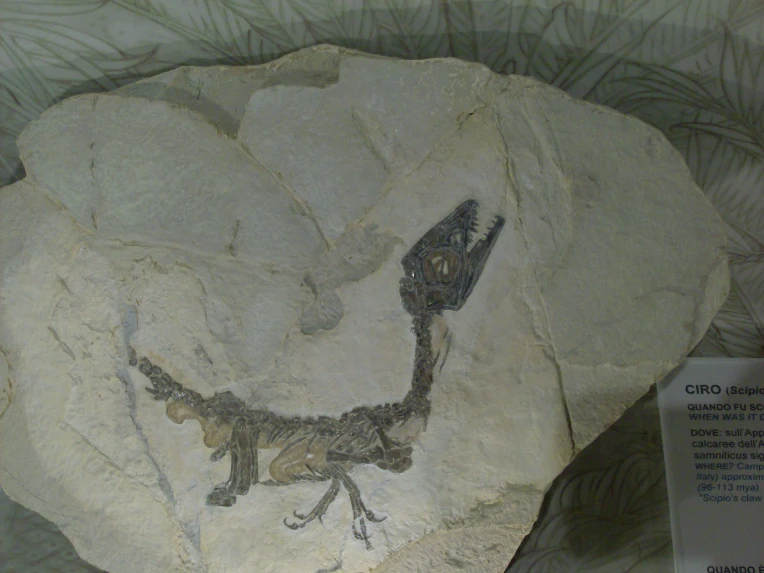
Size?
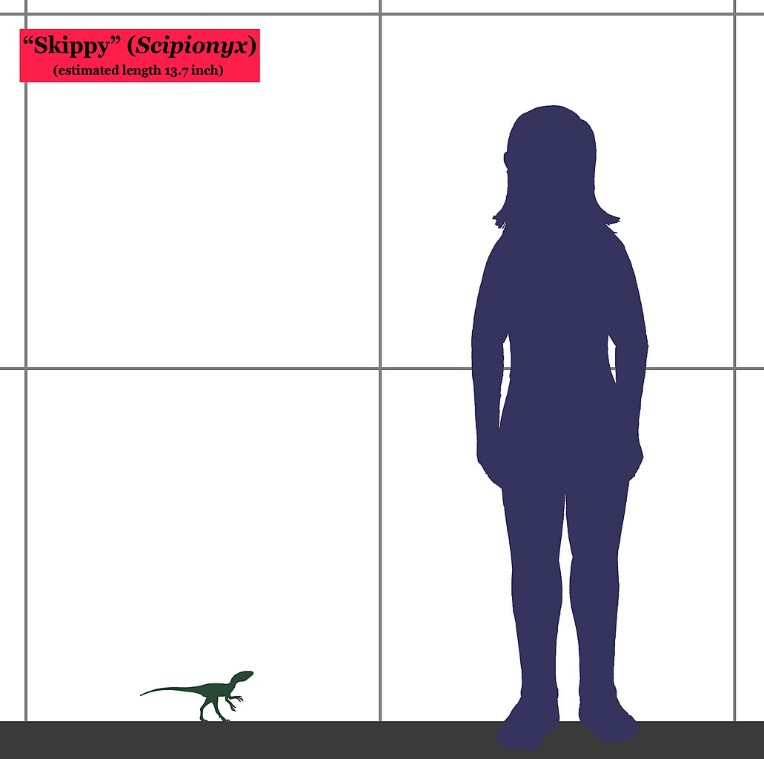
Scipionyx holotype SKIPPY size 01.jpg by Conty, is licensed under the Creative Commons Attribution 3.0 Unported license
Because the holotype is a hatchling of perhaps only a few days old, it is hard to determine the build of the adult animal but some general conclusions can be reliably made. Scipionyx was a small bipedal predator. Its horizontal rump was balanced by a long tail. The neck was relatively long and slender. The hindlimbs and especially the forelimbs were rather elongated. Dal Sasso & Maganuco considered it likely that a coat of primitive protofeathers was present, as these are also known from some direct relatives (3). If you look carefully in the photo, you can see the gut region. Scipionyx is unique in preserving in some form examples from most major internal organ groups: blood, blood vessels, cartilage, connective tissues, bone tissue, muscle tissue, horn sheaths, the respiratory system and the digestive system. Nervous tissue and the external skin, including possible scales or feathers, are absent (4). Here you can see the main organs in this diagram:
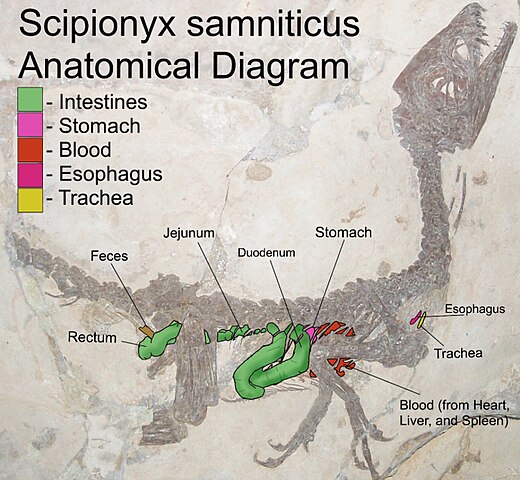
Scipionyx speculative anatomy.jpg by PaleoEquii, 31 October 2018, digitally drawn on top of a Wikipedia image of Scipionyx (File:Scipionyx_samniticus.JPG), is licensed under the Creative Commons Attribution-Share Alike 4.0 International license
The digestive tract of Scipionyx is generally short but wide. The overall length of the intestines — shorter than what was expected — indicates Scipionyx could process food very efficiently. The efficiency would be improved by the visible intestine folds, the plicae circulares, enlarging the absorption surface. Dal Sasso & Maganuco emphasised that a short tract does not necessarily imply that the processing time was short too; retention could have been prolonged to optimise digestion. Most extant vertebrate predators are capable of extracting about 75% of the energetic value of the prey flesh (5).
Antonio
Tethyshadros insularis, the fella you see in the photo is the holotype SC 57021. Tethyshadros is a genus of hadrosauroid dinosaur from the Late Cretaceous (Campanian) Calcare di Aurisina (previously thought to come from the younger Liburnia Formation) of Trieste, Italy. The type and only species is T. insularis. In the 1980s, Alceo Tarlao and Giorgio Rimoli reported finding fragments of dinosaur bone while prospecting for rare bones. The abandoned quarry these were found in was only 100m inland, at Villagio del Pescatore, Trieste Province, Italy. It was from this quarry that a nearly complete hadrosaur skeleton was discovered in 1994. Once finally recovered, it was brought to the Museo Civico di Storia Naturale di Trieste (MCSNT) in the city of Trieste, though it was catalogued as property of the Italian State (SI) rather than under the museum.
The specimen underwent 2800 hours of preparation and was finished in December 2000, when the specimen was publicly presented. It was at this point that the specimen gained the nickname "Antonio", given to it in press reports. In 2004, a book on dinosaurs in Italy by Cristiano Dal Sasso was published which dedicated a chapter to the subject of the hadrosaurs from Trieste (6). The genus was named and described by Dalla Vecchia in 2009 and the genus name refers to the Tethys Ocean and the Hadrosauroidea. The specific name means "insular" or "of the island" in Latin, a reference to the fact that species would have lived on one of the larger islands of the European Archipelago (7). An additional extensive skeleton of Tethyshadros was found at this site, SC 57247, nicknamed "Bruno" (here the link because I ran out of characters....again XD)
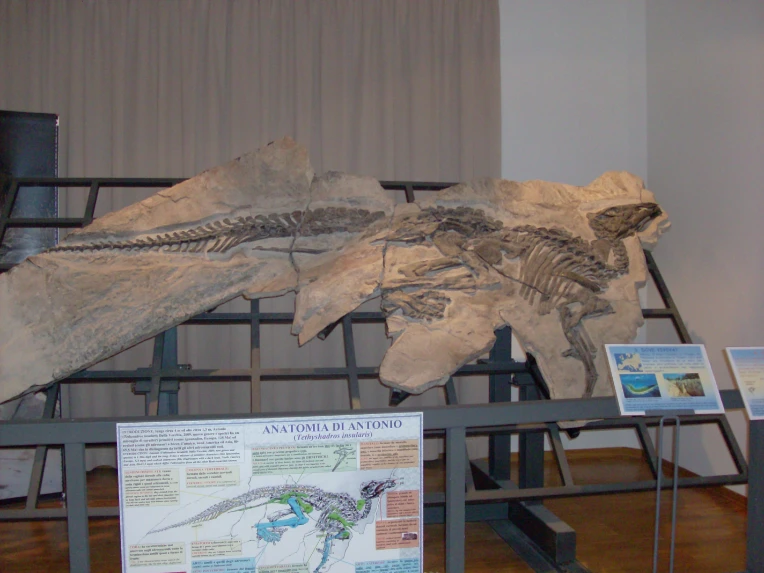
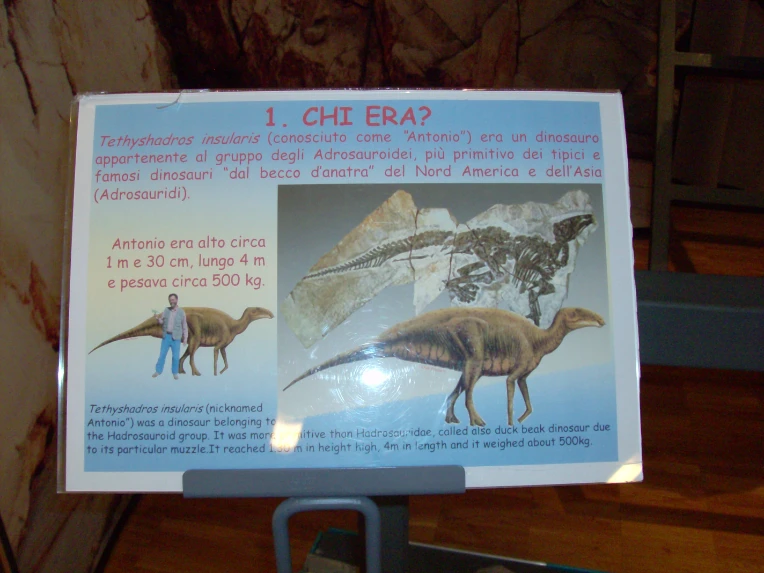
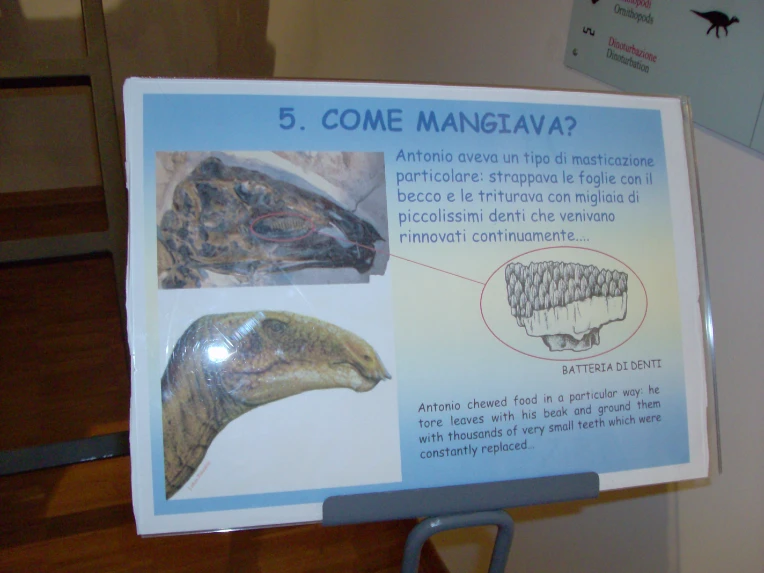
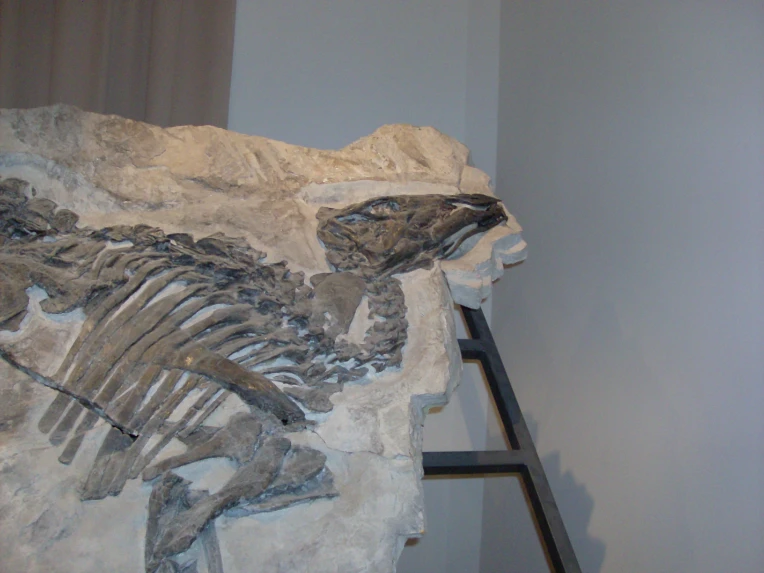
References and footnotes:
(1) Leonardi, G. & Teruzzi, G., 1993, "Prima segnalazione di uno scheletro fossile di dinosauro (Theropoda, Coelurosauria) in Italia (Cretacico di Pietraroia, Benevento)", Paleocronache 1993: 7-14
(2) Cristiano Dal Sasso & Giuseppe Brillante, 2001, Dinosauri italiani, Marsilio pp 256
(3) Cristiano dal Sasso & Simone Maganuco, 2011, Scipionyx samniticus (Theropoda: Compsognathidae) from the Lower Cretaceous of Italy — Osteology, ontogenetic assessment, phylogeny, soft tissue anatomy, taphonomy and palaeobiology, Memorie della Società Italiana de Scienze Naturali e del Museo Civico di Storia Naturale di Milano XXXVII(I): 1-281
(4) Ibidem
(5) Ibidem
(6) Dal Sasso, Cristiano; Brillante, Giuseppe (2004). "'Antonio' and the Hadrosaurs of the Triestine Karst". Dinosaurs of Italy. Bloomington, Indiana: Indina University Press. pp. 99–113. ISBN 0-253-34514-6.
(7) Dalla Vecchia, F. M. (2009). "Tethyshadros insularis, a new hadrosauroid dinosaur (Ornithischia) from the Upper Cretaceous of Italy". Journal of Vertebrate Paleontology. 29 (4): 1100–1116. Bibcode:2009JVPal..29.1100D. doi:10.1671/039.029.0428. S2CID 198128196
https://riviste.unimi.it/index.php/RIPS/article/view/14075










